Abstract
A theoretical investigation is performed of the complexes of a tetracationic porphyrin, tetra-(4-N-methylpyridyl)-porphyrin, (T4MPyP), with the hexanucleotides d(CGCGCG)2 and d(TATATA)2, considering the possibility of both the intercalative and the groove binding interactions. These computations demonstrate that T4MPyP manifests a significant preference for intercalation in its complex with d(CGCGCG)2 but for non intercalative binding in the minor groove in its complex with d(TATATA)2. Such a dual binding behaviour of T4MPyP as a function of the sequence to which it is attached is fully consistent with available experimental data. It demonstrates that intercalation and groove binding may be viewed as two potential wells on a continuous energy surface. In agreement with experiment, the computations indicate that in the here considered case the deepest well is associated with intercalation.
Full text
PDF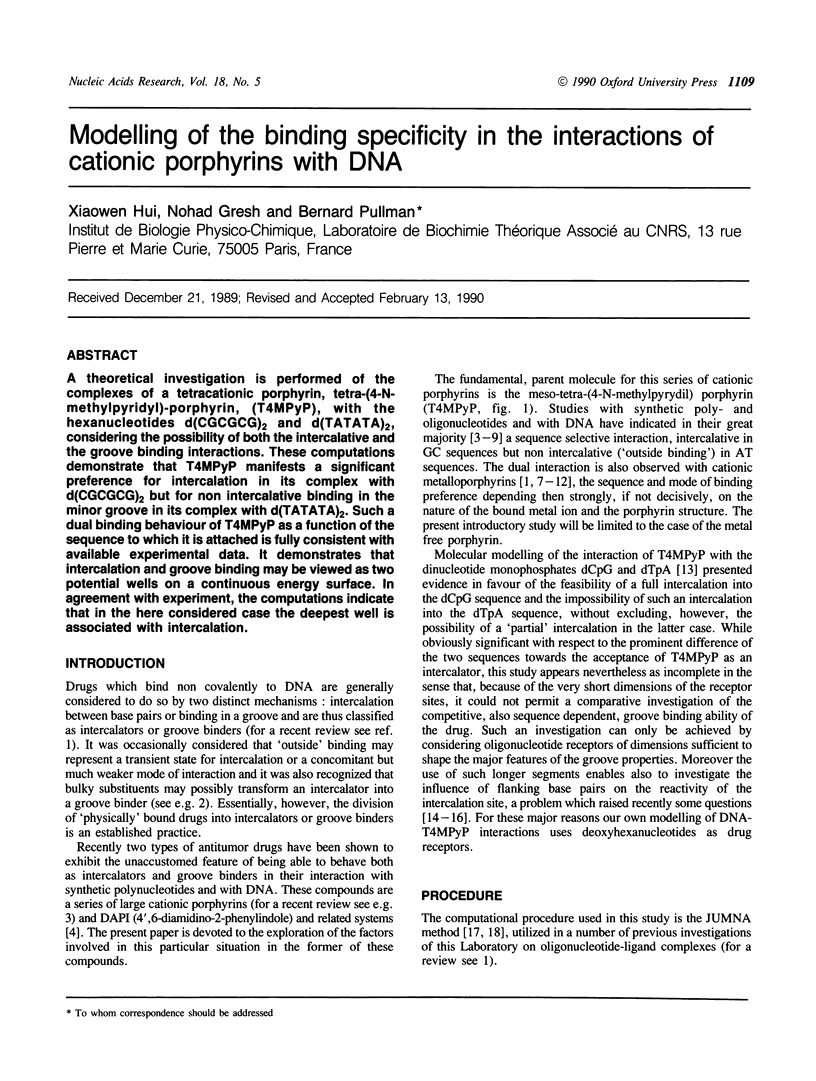
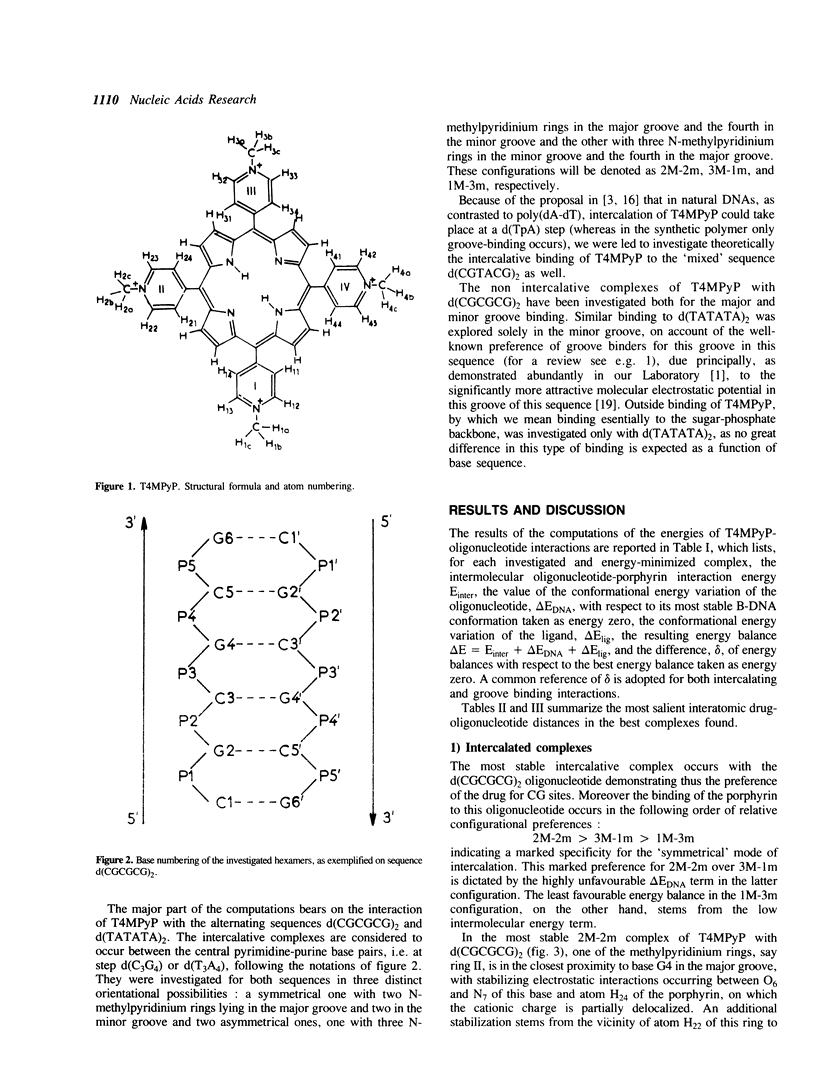
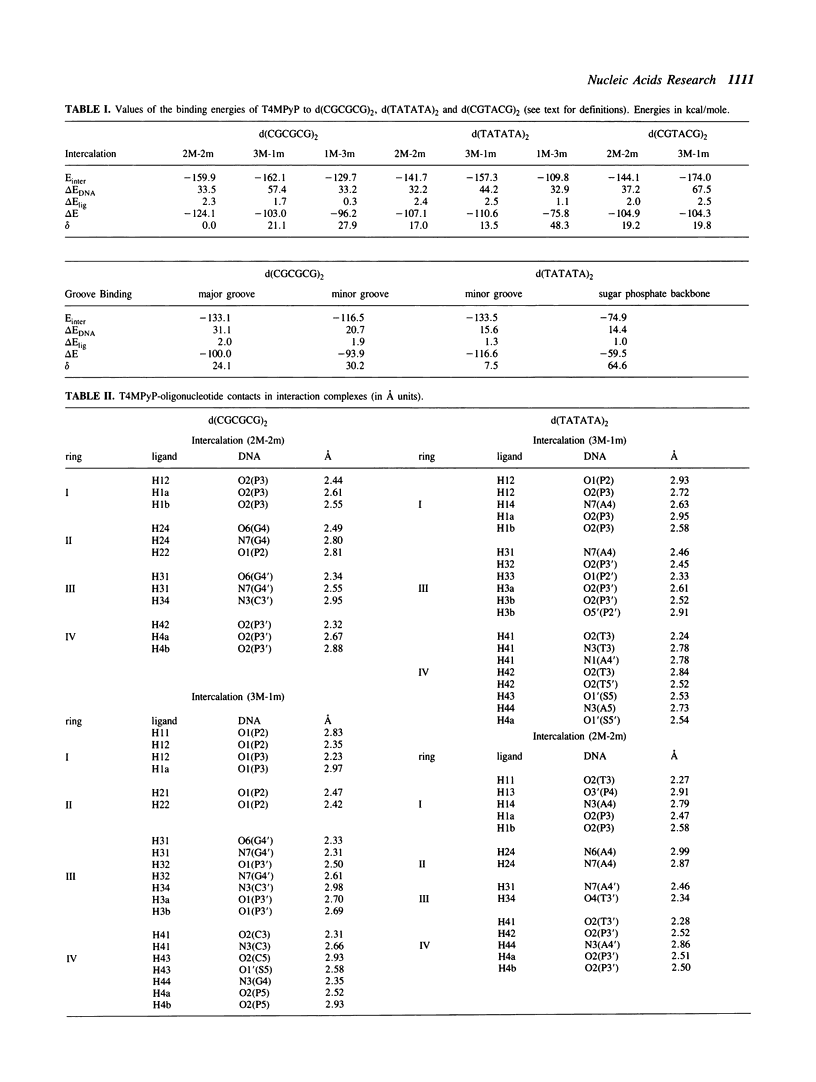
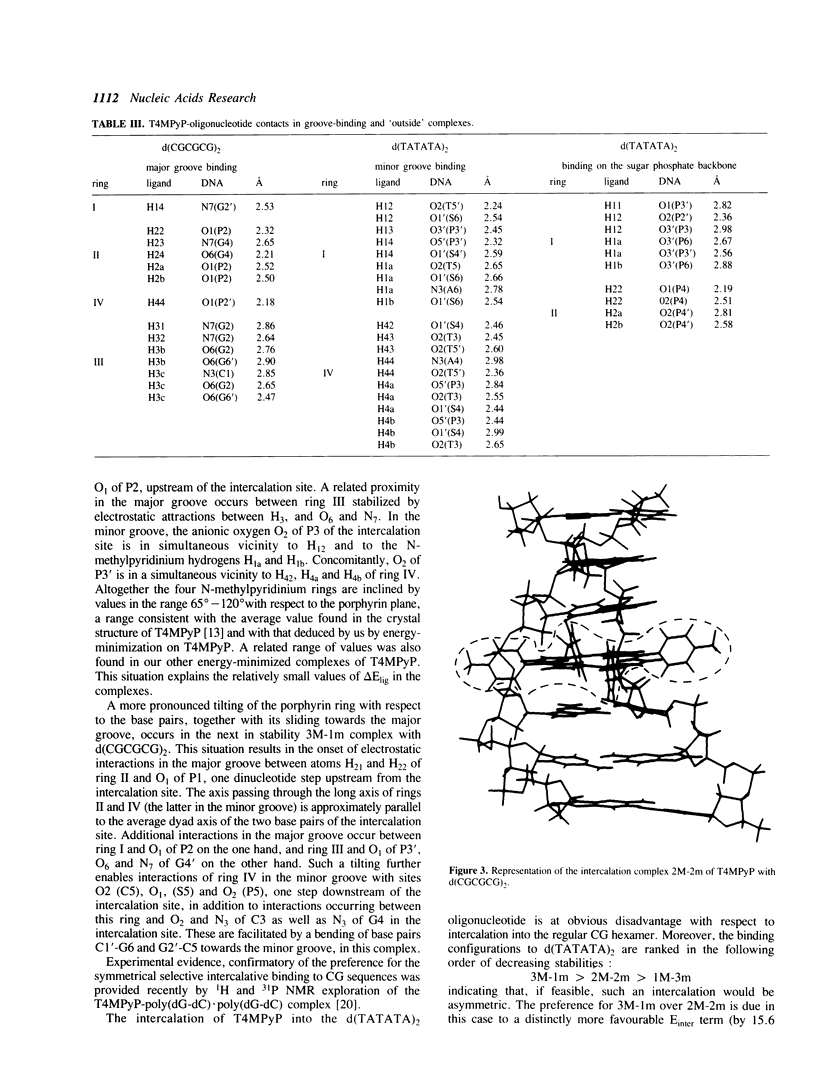
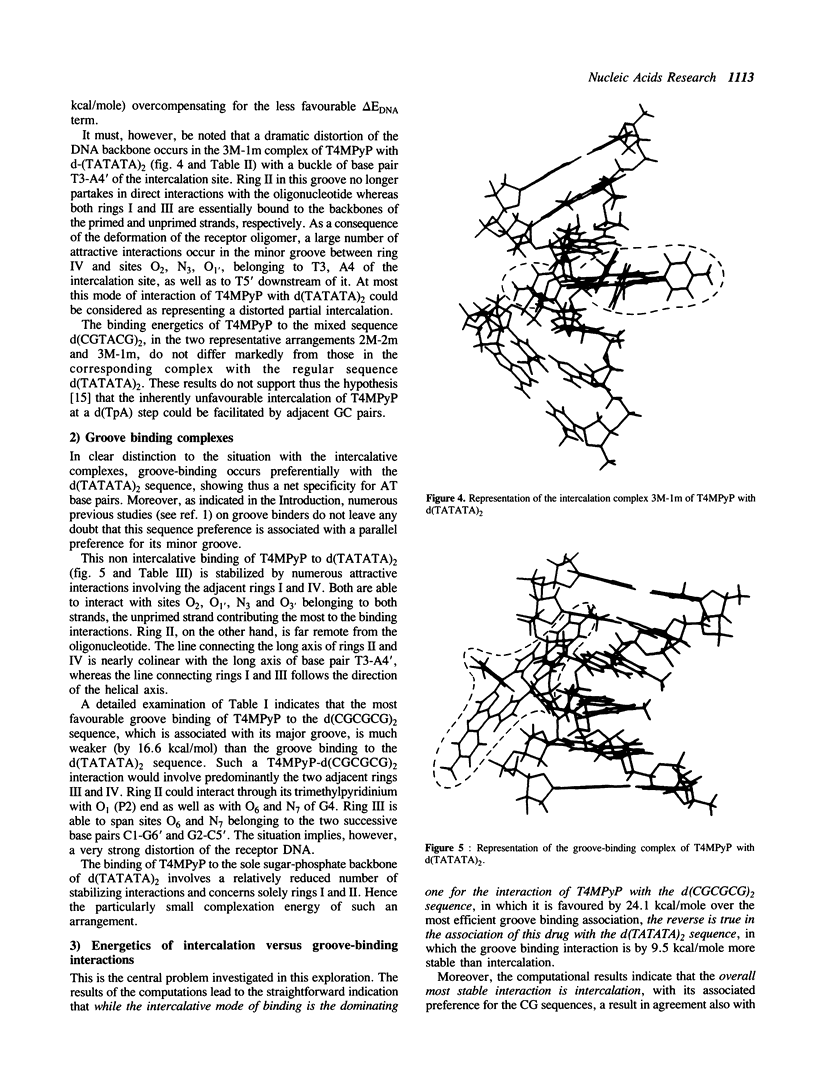
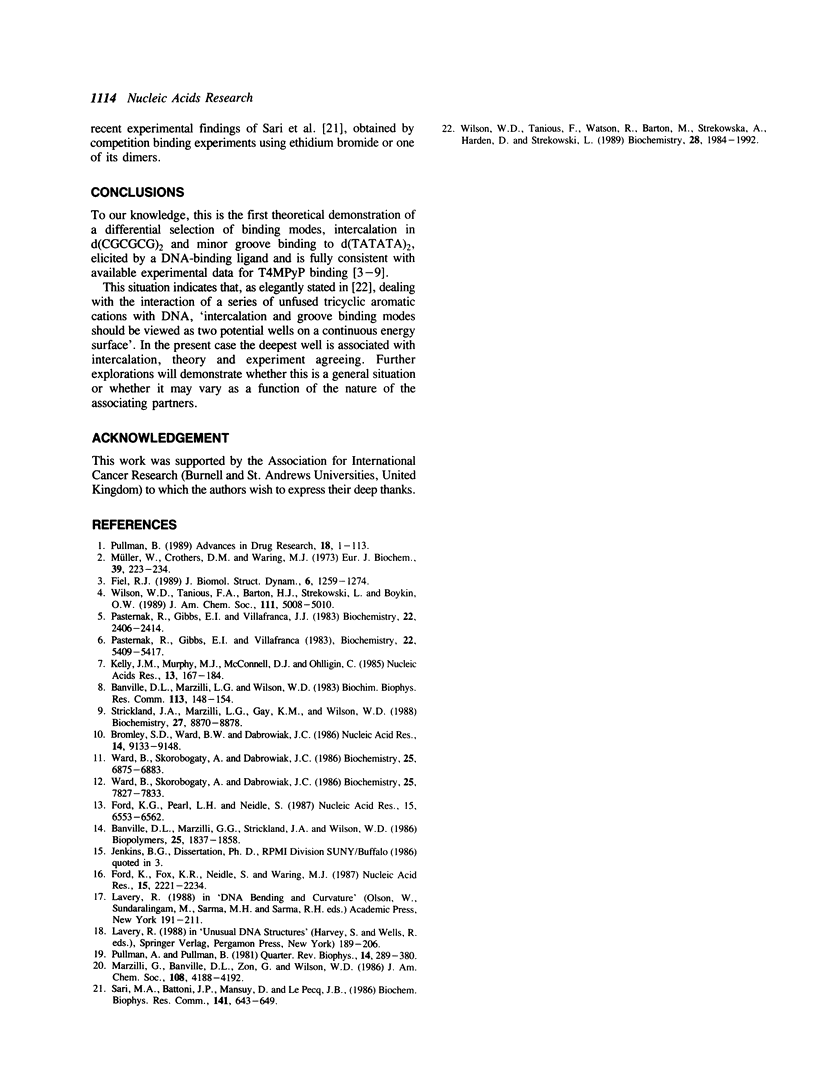
Selected References
These references are in PubMed. This may not be the complete list of references from this article.
- Banville D. L., Marzilli L. G., Strickland J. A., Wilson W. D. Comparison of the effects of cationic porphyrins on DNA properties: influence of GC content of native and synthetic polymers. Biopolymers. 1986 Oct;25(10):1837–1858. doi: 10.1002/bip.360251003. [DOI] [PubMed] [Google Scholar]
- Banville D. L., Marzilli L. G., Wilson W. D. 31P NMR and viscometric studies of the interaction of meso-tetra(4-N-methylpyridyl) porphine and its Ni(II) and Zn(II) derivatives with DNA. Biochem Biophys Res Commun. 1983 May 31;113(1):148–154. doi: 10.1016/0006-291x(83)90444-8. [DOI] [PubMed] [Google Scholar]
- Bromley S. D., Ward B. W., Dabrowiak J. C. Cationic porphyrins as probes of DNA structure. Nucleic Acids Res. 1986 Nov 25;14(22):9133–9148. doi: 10.1093/nar/14.22.9133. [DOI] [PMC free article] [PubMed] [Google Scholar]
- Fiel R. J. Porphyrin-nucleic acid interactions: a review. J Biomol Struct Dyn. 1989 Jun;6(6):1259–1274. doi: 10.1080/07391102.1989.10506549. [DOI] [PubMed] [Google Scholar]
- Ford K. G., Pearl L. H., Neidle S. Molecular modelling of the interactions of tetra-(4-N-methylpyridyl) porphin with TA and CG sites on DNA. Nucleic Acids Res. 1987 Aug 25;15(16):6553–6562. doi: 10.1093/nar/15.16.6553. [DOI] [PMC free article] [PubMed] [Google Scholar]
- Ford K., Fox K. R., Neidle S., Waring M. J. DNA sequence preferences for an intercalating porphyrin compound revealed by footprinting. Nucleic Acids Res. 1987 Mar 11;15(5):2221–2234. doi: 10.1093/nar/15.5.2221. [DOI] [PMC free article] [PubMed] [Google Scholar]
- Kelly J. M., Murphy M. J., McConnell D. J., OhUigin C. A comparative study of the interaction of 5,10,15,20-tetrakis (N-methylpyridinium-4-yl)porphyrin and its zinc complex with DNA using fluorescence spectroscopy and topoisomerisation. Nucleic Acids Res. 1985 Jan 11;13(1):167–184. doi: 10.1093/nar/13.1.167. [DOI] [PMC free article] [PubMed] [Google Scholar]
- Müller W., Crothers D. M., Waring M. J. A non-intercalating proflavine derivative. Eur J Biochem. 1973 Nov 1;39(1):223–234. doi: 10.1111/j.1432-1033.1973.tb03120.x. [DOI] [PubMed] [Google Scholar]
- Pasternack R. F., Gibbs E. J., Villafranca J. J. Interactions of porphyrins with nucleic acids. Biochemistry. 1983 May 10;22(10):2406–2414. doi: 10.1021/bi00279a016. [DOI] [PubMed] [Google Scholar]
- Pasternack R. F., Gibbs E. J., Villafranca J. J. Interactions of porphyrins with nucleic acids. Biochemistry. 1983 Nov 8;22(23):5409–5417. doi: 10.1021/bi00292a024. [DOI] [PubMed] [Google Scholar]
- Pullman A., Pullman B. Molecular electrostatic potential of the nucleic acids. Q Rev Biophys. 1981 Aug;14(3):289–380. doi: 10.1017/s0033583500002341. [DOI] [PubMed] [Google Scholar]
- Sari M. A., Battioni J. P., Mansuy D., Le Pecq J. B. Mode of interaction and apparent binding constants of meso-tetraaryl porphyrins bearing between one and four positive charges with DNA. Biochem Biophys Res Commun. 1986 Dec 15;141(2):643–649. doi: 10.1016/s0006-291x(86)80221-2. [DOI] [PubMed] [Google Scholar]
- Strickland J. A., Marzilli L. G., Gay K. M., Wilson W. D. Porphyrin and metalloporphyrin binding to DNA polymers: rate and equilibrium binding studies. Biochemistry. 1988 Nov 29;27(24):8870–8878. doi: 10.1021/bi00424a027. [DOI] [PubMed] [Google Scholar]
- Ward B., Skorobogaty A., Dabrowiak J. C. DNA binding specificity of a series of cationic metalloporphyrin complexes. Biochemistry. 1986 Dec 2;25(24):7827–7833. doi: 10.1021/bi00372a007. [DOI] [PubMed] [Google Scholar]
- Ward B., Skorobogaty A., Dabrowiak J. C. DNA cleavage specificity of a group of cationic metalloporphyrins. Biochemistry. 1986 Nov 4;25(22):6875–6883. doi: 10.1021/bi00370a021. [DOI] [PubMed] [Google Scholar]


